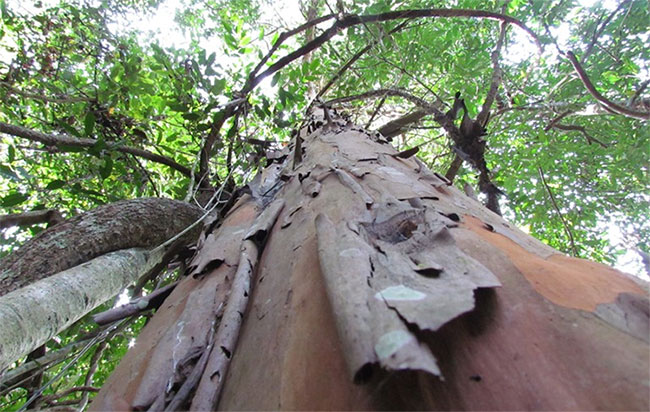Finding a powerful killer for cancer cells from the Central Highlands forest tree
A new active ingredient discovered from the pinnacle tree has the effect of inhibiting many diseases such as lung, liver, epithelial and breast cancer.
In the process of studying 15 species of conifers in the Central Highlands , scientists from the Vietnam Museum of Nature discovered peak pine trees with strong biological activity with cells that are not beneficial to humans.
The team selected trees: peaks, flat leaves, needles that delivered mountains and mountains to isolate and find valuable compounds for medicine. Of the 33 compounds from these four plants, two galangnins and isolariciresino l were first detected in flat pine pine and a new norisoharringtonine substance from the apical bark and leaves.

Mature pinnacles are being strictly protected in Lam Dong.(Photo: NVCC).
Newly discovered substances from pinnacle trees are extracted into active ingredients to affect cultured cancer cells in the laboratory. As a result, epithelial cancer cells (KB), liver cancer (Hep-G2), lung cancer (LU) and breast, are strongly inhibited.
Associate Professor Dinh Thi Phong (Vietnam Museum of Nature, chairman of the project) said that many species of wild plants have resistance to one type of cancer, but their activity is not strong and can weaken when impacted on health. cell. Particularly, norisoharringtonine active with many cancers without being reduced when it affects the cells.
However, to apply research into medicine production is a long way. After laboratory results, new active ingredients need to be tested in mice and clinically on humans.
Another difficulty is that extremely scarce inputs are only valid when extracted from 5-10 year old mature trees. Whereas, yew tree is in danger of extinction. Lam Dong province currently has only 34 peak trees, including five mature trees.
The Central Highlands forest, which has a thick humus carpet, has seeds that are difficult to germinate to the soil layer, resulting in very few opportunities for this species to regenerate naturally. Therefore, the research team proposed to the locality to find a solution to develop the peak populations, to conserve precious genetic resources.
Peaked tree - scientific name Cephalotaxaceae - is an ancient plant.
Scattered trees in small trees or shrubs in tropical forests are often rainy season, at an altitude of about 600 - 1,500 m, where there is little light, on the soil layer is thick and humid.
In Vietnam, the apical tree is distributed in Ha Tay (Ba Vi), Thanh Hoa (Lung Van), Quang Tri (between Hon Rao and A Dua), Thua Thien Hue, Kontum (Dac Glay, Dac To: Ngoc Pan, Sa Teacher), Gia Lai, Lam Dong (Di Linh: Braian mountain). Hainan Island (China) also discovered peak parts.
High quality topwood, resistant to termite, is used for high-end handicrafts. Seeds have medicinal properties, while Hai Nam apex shell is used to treat fever (Tripp, 1995).
- Scientists found 8 new orchids in the Central Highlands
- Detecting cancer cell kill substance in a forest tree
- Poisonous picture of the elephant hunt in the Central Highlands 100 years ago
- Vietnamese science propagates precious forest plants that treat liver cancer
- The most exotic trees on Earth
- Central and Central Highlands worry that El Nino will appear
- New tree clones in the Central Highlands
- Find out how to make blood cancer cells kill each other
- Image of cancer cells under a microscope
- Thousands of years old oak forest revealed after the storm
- Discovered forest tree species resistant to four strains of cancer
- Stop the cancer by ... Viagra and the flu vaccine
 Why is Australia the country with the highest cancer rate in the world while Vietnam ranks 100th?
Why is Australia the country with the highest cancer rate in the world while Vietnam ranks 100th? New drug causes cancer to 'starve'
New drug causes cancer to 'starve' Common cancers in men
Common cancers in men America's incredible discovery: The most feared cancer cell is love
America's incredible discovery: The most feared cancer cell is love